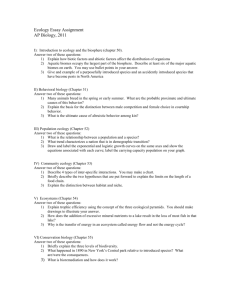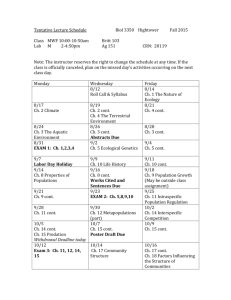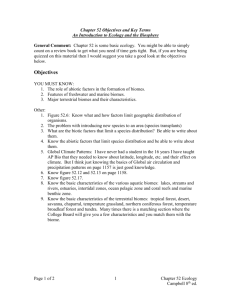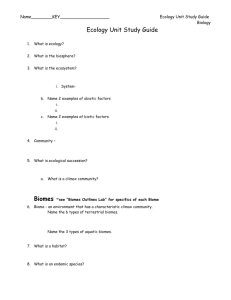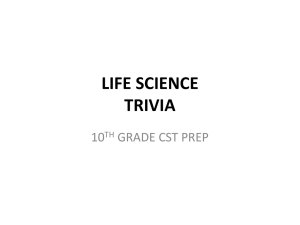AP Biology Summer Homework
advertisement
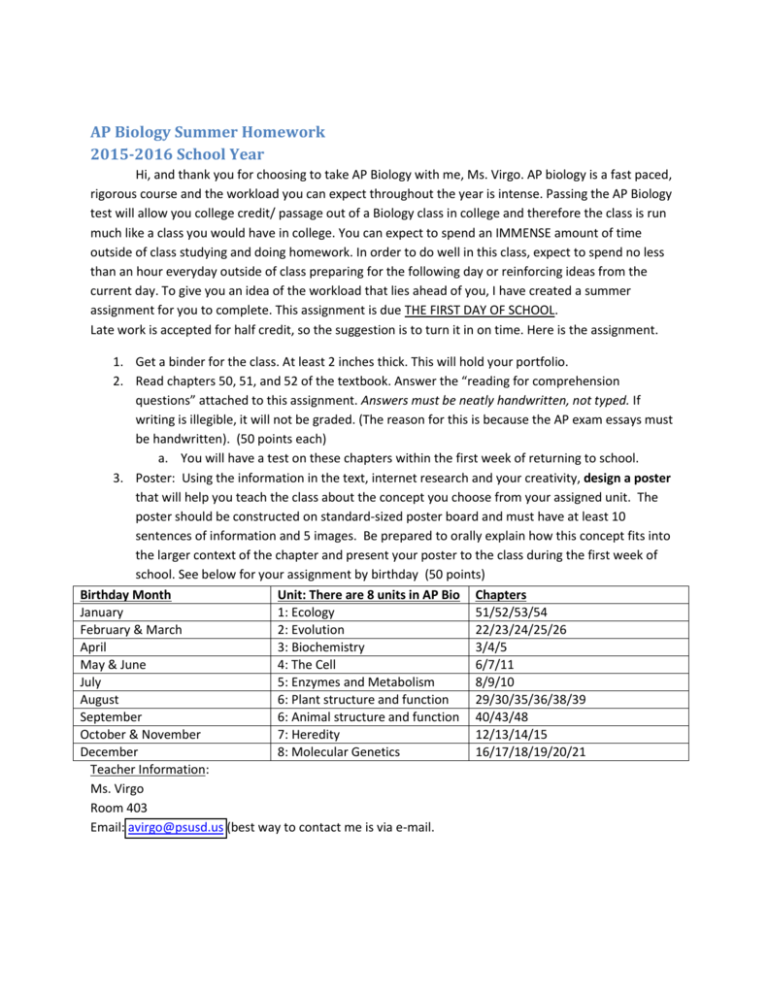
AP Biology Summer Homework 2015-­‐2016 School Year Hi, and thank you for choosing to take AP Biology with me, Ms. Virgo. AP biology is a fast paced, rigorous course and the workload you can expect throughout the year is intense. Passing the AP Biology test will allow you college credit/ passage out of a Biology class in college and therefore the class is run much like a class you would have in college. You can expect to spend an IMMENSE amount of time outside of class studying and doing homework. In order to do well in this class, expect to spend no less than an hour everyday outside of class preparing for the following day or reinforcing ideas from the current day. To give you an idea of the workload that lies ahead of you, I have created a summer assignment for you to complete. This assignment is due THE FIRST DAY OF SCHOOL. Late work is accepted for half credit, so the suggestion is to turn it in on time. Here is the assignment. 1. Get a binder for the class. At least 2 inches thick. This will hold your portfolio. 2. ZĞĂĚĐŚĂƉƚĞƌƐϱϬ͕ϱϭ͕ĂŶĚϱϮŽĨƚŚĞƚĞdžƚŬ͘ŶƐǁĞƌƚŚĞ͞ƌĞĂĚŝŶŐĨŽƌĐŽŵƉƌĞŚĞŶƐŝŽŶ ƋƵĞƐƚŝŽŶƐ͟ĂƚƚĂĐŚĞĚƚŽƚŚŝƐĂƐƐŝŐŶŵĞŶƚ͘Answers must be neatly handwritten, not typed. If writing is illegible, it will not be graded. (The reason for this is because the AP exam essays must be handwritten). (50 points each) a. You will have a test on these chapters within the first week of returning to school. 3. Poster: Using the information in the text, internet research and your creativity, design a poster that will help you teach the class about the concept you choose from your assigned unit. The poster should be constructed on standard-­‐sized poster board and must have at least 10 sentences of information and 5 images. Be prepared to orally explain how this concept fits into the larger context of the chapter and present your poster to the class during the first week of school. See below for your assignment by birthday (50 points) Birthday Month Unit: There are 8 units in AP Bio Chapters January 1: Ecology 51/52/53/54 February & March 2: Evolution 22/23/24/25/26 April 3: Biochemistry 3/4/5 May & June 4: The Cell 6/7/11 July 5: Enzymes and Metabolism 8/9/10 August 6: Plant structure and function 29/30/35/36/38/39 September 6: Animal structure and function 40/43/48 October & November 7: Heredity 12/13/14/15 December 8: Molecular Genetics 16/17/18/19/20/21 Teacher Information: Ms. Virgo Room 403 Email: avirgo@psusd.us (best way to contact me is via e-­‐mail. 5HDGLQJIRU&RPSUHKHQVLRQ&DPSEHOO·V%LRORJ\&KDSWHU All answers are to be completed on your own paper, neatly written. Each part is to be clearly separated from the others by written heading. Include your name, the title of the assignment, and chapter number on your answer sheet. Late assignments will not be accepted. Directions for part 1: Answer the following questions. 1. What is ecology? 2. Why has ecology traditionally been a descriptive science and not an experimental science? 3. What is the difference between biotic and abiotic factors? 4. What is an ecosystem and what does in include? What is the biosphere? 5. What causes the seasons on Earth? 6. What causes a rain shadow? 7. Describe the vertical stratification of aquatic biomes. Note that this description is for both freshwater and marine biomes. 8. Define detritus. How is it important to an aquatic ecosystem and where does it come from? 9. Explain the difference between natural eutrophication and cultural eutrophication. Discuss some of the causes of cultural eutrophication. See page 1204 in chapter 54 for additional information. 10. List and briefly describe 8 major terrestrial biomes. 11. List and briefly describe 3 major regions of the marine biome. Directions for part 2: Complete the Self quiz at the end of the chapter. After completing the questions, check your answers from the key at the end of the review. After the letter of each correct answer, explain why it was correct. This may entail describing why the other answers are incorrect. Directions for part 3: Complete the following questions. Outline form is NOT acceptable. Labeled diagrams may be used to supplement discussion, but in no case will a diagram alone suffice. It is important that you read each question completely before you begin to write. 1. How is population size regulated by abiotic and biotic factors? Describe four abiotic factors in your explanation and give examples of how that factor affects a specific population. 2. Describe homeostasis (chapter 40) and how different organisms maintain homeostasis. Discuss the meanings of regulators and conformers. In you discussion, describe why few organisms can be considered perfect regulators or perfect conformers.
